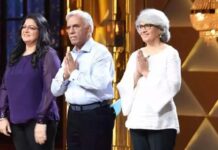K. L. Saigal Biography: Kundanlal Saigal, also known as K. L. Saigal, was born on April 11, 1904. Google honoured the multifaceted artist on his 114th birthday with a Google Doodle. K. L. Saigal, renowned for his distinctive vocal, has recorded over 185 songs throughout his career. He worked on 36 films in three languages, including 28 in Hindi, seven in Bengali, and one in Tamil, and established himself as one of the first genuine Bollywood superstars. Among his most successful and popular films were Yahudi Ki Ladki, Bhukt Surdas, Tansen, Devdas, Street Singer, and Lagan.
K. L. Saigal Biography: Birth Anniversary
| Name: | K.L Saigal |
| Nationality: | Indian |
| Date of Birth: | March 11, 1904 |
| Place of Birth: | Jammnu |
| Died: | January18, 1947 |
| Genres: | Playback Singing |
| Gender: | Male |
| Profession: | Singer, Actor |
K. L. Saigal Early Years
Saigal was born in Jammu on April 11, 1904, to a Punjabi family. His father, Amarchand Saigal, was a tehsildar at the court of the Maharaja Pratap Singh of Jammu and Kashmir, while his mother, Kesarbai Saigal, was a profoundly religious, music-loving Hindu woman. She used to bring her infant son to religious functions where traditional styles based on classical Indian music were sung in bhajan, kirtan, and shabad. Saigal was the fourth-born of five children, coming after two older brothers and an older sister and before a younger brother. His formal education was limited and unremarkable. As a youth, he occasionally performed the Sitar in Jammu’s Ramlila. He was the first cousin of Chaman Puri, Madan Puri, and Amrish Puri, all of whom were well-known character actors.
Saigal pulled out of school and began his career as a railway timekeeper. Later, he worked as a typewriter salesman for the Remington Typewriter Company in Simla (now Shimla), which gave him the opportunity to travel throughout India.
At the Anarkali Bazaar in Lahore, he met Mehrchand Jain, who would later establish the Assam Soap Factory in Shillong. When they both relocated to Calcutta, Mehrchand and Kundan remained close companions and attended numerous mehfil-e-mushairas. Saigal was an aspiring singer at the time, and Mehrchand encouraged him to cultivate his talent.
Lionel Messi Biography: Age, Birthday, Early life, Salary, Assets, Personal Life, Net Worth
K.L’s Profession
Harishchandra Bali, a classical musician and music director, invited K.L. Saigal to Calcutta and introduced him to R. C. Boral in the early 1930s. R.C. Boral was immediately impressed by his abilities. B. N. Sircar’s Calcutta-based film studio New Theatres employed Saigal on an Rs. 200 per month contract. There, he met contemporary figures such as Pankaj Mullick, K. C. Dey, and Pahari Sanyal.
In the meantime, the Indian Gramophone Company had published Saigal’s record containing a couple of Harishchandra Bali-composed Punjabi songs. Thus, Bali became the first music director for Saigal. Mohabbat Ke Ansu was the first film in which Saigal appeared, followed by Subah Ka Sitara and Zinda Lash, all of which were released in 1932. However, these films were not very successful. Saigal used the name Saigal Kashmiri for his first three films before adopting his own name Kundan Lal Saigal (K. L. Saigal) beginning with Yahudi Ki Ladki. (1933).
In India, four bhajans rendered by Saigal for the film Puran Bhagat in 1933 caused a sensation. The films Yahudi Ki Ladki, Chandidas, Rooplekha, and Karwan-E-Hayat followed. Lata Mangeshkar is rumoured to have expressed her desire to marry K.L. Saigal as a young woman after viewing his performance in Chandidas. (1934).
K. L. Saigal Facts:
- As a youth, K. L. Saigal received an informal music education by singing at local shrines and religious ceremonies with his mother, due to his modest upbringing.
- In addition to working as a timekeeper, salesman, and manager, he pursued performing on the side.
- His first film, Mohabbat Ke Ansu, was released in 1932, marking KL Saigal’s breakthrough.
- For his first three films, he used the name Saigal Kashmiri, but for his 1933 film Yahudi Ki Ladki, he used his own name Kundan Lal Saigal (KL Saigal).
- While he began his career singing Punjabi tunes, the actor and singer from Jammu also learned Bengali and acted in and sang for several Bengali films.
- KL Saigal performed “Babul Mora Naihar Chhooto Jaye” live in front of the camera in the film Street Singer, despite the fact that playback singing was the preferred method of singing at the time.
- As a singer, K. L. Saigal has produced memorable songs such as “Jab Dil Hi Toot Gaya,” “Bangla Bane Nyara,” “Balam Aaa Baso Moray Man Mein,” “Do Naina Matware,” and “Mere Sapnon Ki Rani,” among others.
- K. L. Saigal became an alcoholic and died on January 18, 1947, at the age of 42 in his ancestral city of Jalandhar.
- His wife Asha Rani and four children survived him. While Madan Mohan, Nina, and Bina were his biological children, he had adopted Durgesh Nandani, the daughter of his late older sibling, when he was still a bachelor.
- Hindi Film playback vocalists such as Lata Mangeshkar, Kishore Kumar, Mohammad Rafi, and Mukesh revered and idolised K. L. Saigal’s distinctive singing style.




